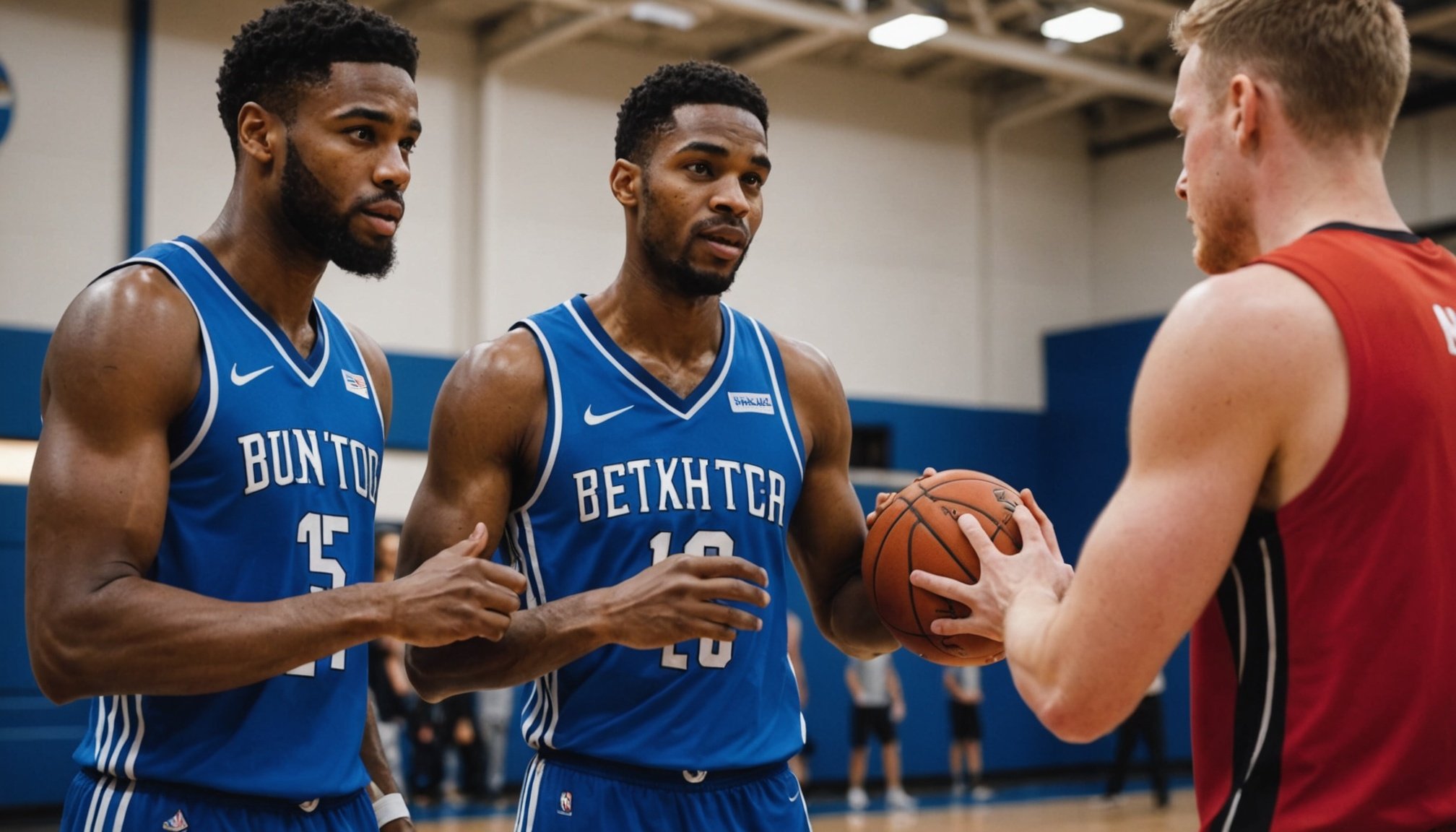Overview of Heart Rate Monitors for Basketball
In the quest for enhanced athletic performance, heart rate monitors have emerged as indispensable tools, notably in basketball training. These devices allow athletes and coaches to gain insights into cardiovascular exertion levels, optimising training regimes for peak efficiency. Monitoring heart rates helps assess stamina, recovery times, and overall fitness progression during rigorous basketball sessions.
There are several types of heart rate monitors suitable for athletes. Traditional chest-strap monitors remain popular due to their high precision, making them ideal for intensive sports like basketball. Wrist-worn monitors, although sometimes marginally less precise, offer more comfort and ease of use, appealing to those valuing convenience alongside functionality. Other innovations in sports technology include in-ear and optical sensors, each catering to different preferences.
Also read : Elevate your vertical leap: the ultimate strength training blueprint for basketball athletes in the uk
When selecting a heart rate monitor for basketball, several key features must be evaluated. Accuracy remains paramount, particularly in high-intensity sports. Battery life is another critical factor, ensuring devices can endure lengthy training sessions. Durability and resistance to sweat also enhance the usability of a monitor, while compatibility with existing training apps can expand functionality via data analysis. By considering these features, athletes can choose a monitor that effectively supports their training goals.
Selecting the Right Heart Rate Monitor
Choosing a heart rate monitor for basketball can significantly enhance your training efficiency. Key factors such as accuracy, comfort, and connectivity should be prioritized. It’s crucial to compare these features to find a device that meets your specific needs.
In parallel : Maximizing performance potential: the essential role of strength and conditioning in training uk basketball athletes
Accuracy is vital, as it ensures the data you rely on is precise, enabling informed decisions about your training intensity. Heart rate monitors with advanced sensors provide more reliable real-time measurements. Comfort is equally essential, especially for extensive sessions. Look for devices with adjustable straps and lightweight materials—features that contribute to a seamless experience.
For basketball enthusiasts, monitors offering seamless connectivity with smartphones or tablets can enrich your post-training analysis. This connectivity allows effortless tracking and reviewing of your progress over time.
In the UK market, well-regarded brands such as Garmin, Polar, and Fitbit offer heart rate monitors tailored to rigorous activities like basketball. These brands build their reputation on performance and reliability, making them solid choices for committed athletes. Expert insights consistently highlight Garmin’s edge in durability and Polar’s innovative features that cater to sports-specific nuances. Emphasizing informed selection ensures that athletes can maximize performance benefits from their chosen heart rate monitor.
Understanding Heart Rate Zones
Understanding heart rate training zones is crucial for optimizing basketball training sessions. Different heart rate zones represent varied levels of workout intensity, ranging from low-intensity (Zone 1) to maximum effort (Zone 5).
Each zone serves a distinct purpose. For instance, Zone 2 enhances aerobic capacity and endurance, essential for maintaining energy during games. Zone 4, however, focuses on improving VO2 max, a key performance metric.
To determine your personal heart rate zones, calculating your maximum heart rate is essential. The simplest method is subtracting your age from 220. Once you have this figure, calculate the percentage ranges for each zone:
- Zone 1: 50-60% of max
- Zone 2: 60-70% of max
- Zone 3: 70-80% of max
- Zone 4: 80-90% of max
- Zone 5: 90-100% of max
In basketball, these zones can enhance training efficiency. Focus on different zones for various training goals. For instance, use Zone 2 training during off-season to build a strong aerobic base, then switch to Zone 4 to sharpen speed and agility during peak season.
Integrating heart rate zones into your sessions enables precision training, maximizing both effort and outcome.
Integrating Heart Rate Monitors into Training Regimens
Incorporating heart rate monitors into training programs can significantly boost athletes’ performance tracking. Here’s a step-by-step guide to seamlessly include these devices in your routine.
First, begin by wearing the monitor during basketball drills. This allows you to collect initial data. Once you have this baseline, analyze it to identify patterns or training areas that require improvement. Adjust training programs accordingly—perhaps slowing down high-intensity basketball drills if the heart rate spikes excessively.
Next, integrate the monitor into game settings. Heart rate fluctuations during games offer insights into players’ stress responses beyond typical practice environments. It’s crucial to differentiate between heart rate data gathered from games versus practices, as this can inform how training programs may need modifications. Practicing specific basketball drills that mimic game intensity with the monitor can bridge the gap between training and performance.
Finally, use accumulated data from both settings to fine-tune your regimen. Regular adjustments based on heart rate ensure that the athlete is neither overtraining nor undertraining, ultimately improving overall performance tracking. Regular assessment propels growth, ensuring athletes meet their peak potential in every game.
Analyzing Data from Heart Rate Monitors
Understanding data analysis from heart rate monitors is essential in enhancing your athletic performance. Interpreting the provided data effectively can give immense insights into one’s fitness journey. This data allows athletes to focus on performance improvement by tracking changes, adjusting their routines, and making data-driven decisions. Training attunement becomes achievable through focusing on heart rate variations during different exercises or over extended periods.
A valuable way to assess your performance improvements over time is by analyzing trends in your resting and active heart rates. If your resting heart rate decreases over weeks of consistent training, this often indicates improved cardiovascular efficiency. A steady or increased active heart rate at lower exertion levels might suggest room for improvement or a need to modify training intensity.
Practical adjustments to your training regime should be based on observed data insights. For instance, increasing the intensity of workouts when heart rate data reveals consistent underperformance can lead to better overall fitness. Conversely, elevated heart rates during minimal activity might indicate overtraining, prompting rest or reduced exercise intensity.
By embracing detailed data analysis of your heart rate monitor, you can foster a deeper connection between your workouts and health goals, maximizing performance gains.
Expert Tips for Maximizing Training Efficiency
When it comes to training efficiency, incorporating insights from fitness experts can be transformative. A key tool in achieving optimal athlete performance is the heart rate monitor. This device provides precise feedback that allows athletes to tailor their workouts for maximum impact and avoid common pitfalls.
Best Practices with Heart Rate Monitors
Experts recommend using heart rate monitors to ensure you’re training within the optimal heart rate zones. This approach prevents overtraining and minimizes the risk of fatigue or injury. By paying attention to your heart rate, you can adjust the intensity of workouts in real-time, upholding training efficiency.
Common Mistakes to Avoid
One frequent error is neglecting to establish personal baseline metrics. Experts advise against comparing heart rates across different individuals without considering personal physiological differences. Athletes should also regularly calibrate their monitors for accurate readings, avoiding reliance on potentially misleading data.
UK Basketball Case Studies
In real-life examples, several UK basketball players have enhanced their athlete performance using proper heart rate monitoring techniques. By continuously aligning their training routines with real-time data, these athletes observed significant improvements in stamina, reaction times, and overall game performance. This tangible success underlines the practical benefits of integrating expert advice and precise monitoring into athletic training routines.
Conclusion and Next Steps
Understanding the importance of heart rate monitoring can significantly enhance athletic performance and training efficiency. Basketball players in the UK, this is your opportunity to elevate your game by incorporating this valuable tool into your routine. By regularly using heart rate monitors, athletes can achieve optimal intensity levels, ensure efficient recovery periods, and personalise training sessions for ongoing performance enhancement.
As you proceed with your training regimen, consider these next steps for effective implementation:
- Explore various options for heart rate monitors that align with your needs.
- Create a training plan incorporating heart rate zones for measurable progress.
- Continuously monitor and evaluate your performance to adjust strategies accordingly.
Resources are available to help deepen your understanding of this tool and maximize its effectiveness. Consider online platforms and expert consultations to further your knowledge on heart rate variability and adaptive training responses. Align with peers or coaches who have expertise in this area for guidance on improving usage techniques and setting achievable objectives.
Taking these next steps towards informed training through heart rate monitoring is a journey that promises fruitful gains in skills and stamina development. Embrace these practices, and you will see tangible results on the court.











